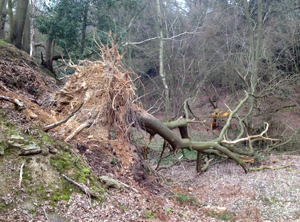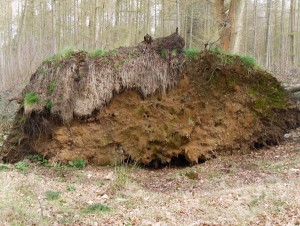How to grow a better tree.

In 1987, the U.K. was battered by a storm – said to have been the worst that this country has experienced in three hundred years. Hurricane force winds raged across southern England and the Midlands before the storm finally exited via the Wash. It is often referred to as “The Great Storm”
Millions of trees were uprooted, woodlands flattened, parks and gardens destroyed, the National Grid damaged, cars hit by falling branches and people died. Places like Wakehurst Place, the Sussex outpost of the Royal Botanic Gardens (Kew) lost some 60% of their tree collection as a result of this storm. Kew Gardens itself lost many trees. Many were uprooted and died.
However, one tree - a Turner's Oak was uprooted but fell back into "its hole". Prior to the storm, the tree was not well - its leaves were small and it generally lacked vigour, and was considered to be in decline.. As there was much to do after the storm, it was some time until the Kew staff got back to the Oak. Three years down the line, the tree was 'revitalised', it had grown and generally looked to be much better. The tree had been suffering from soil compaction; it had been a convenient shelter for people in the event of rain etc. The lifting of the tree by the high winds had loosened the soil and allowed water and air to reach the roots, and created space.
 Kew now does remedial work around trees in such settings using an AIRSPADE (link opens a pdf). This uses nitrogen gas to break up the soil around roots - without damaging the roots themselves. The permeability of the soil to water and gases (oxygen and carbon dioxide) is improved.
Kew now does remedial work around trees in such settings using an AIRSPADE (link opens a pdf). This uses nitrogen gas to break up the soil around roots - without damaging the roots themselves. The permeability of the soil to water and gases (oxygen and carbon dioxide) is improved.
Post-storm, there were 'unlimited' opportunities to examine the root systems of trees that had been blown over, a Tree Root survey was undertaken. This revealed that the old adage / saying "What you get above ground is what you get below ground" is simply not true. Generally, speaking trees in temperate regions have shallow root plates. Most trees have a depth between 50 and 100 cm, and few go deeper than 80 cm.
After examining fallen trees and the extensive literature on tree planting, the staff at Kew established simple rules for new tree planting.
- Don't dig and plant too deep, young trees do not want to sit in a puddle of water. This can result in a slow and lingering death.
- They use a square shaped hole, which is easier to dig and offers corners for the roots to 'break out' in search of water and minerals.
- They also 'plant tight', with no staking. This is to prepare the trees for the next storm / high winds. if tied up, they do not "get used to movement'. If they are not tethered or staked then they move and sway in the wind; this encourages the formation of anchor roots and an increase in the size of the trunk to support the crown of the tree.

"old" root plate
Comments are closed for this post.
Discussion
We stake and protect -In Scotland we plant in tubes with stakes to anchor the tubes, to protect against deer, voles, rabbits and hares. All herbivores will eat trees. We take the tubes off after the trunk is big enough to withstand wind and eating.

Away from munchy animals, small trees well planted can easily withstand wind. I totally agree on doing without staking and have often succeeded in persuading friends and neighbours to remove theirs.
Miles Newman
21 May, 2016